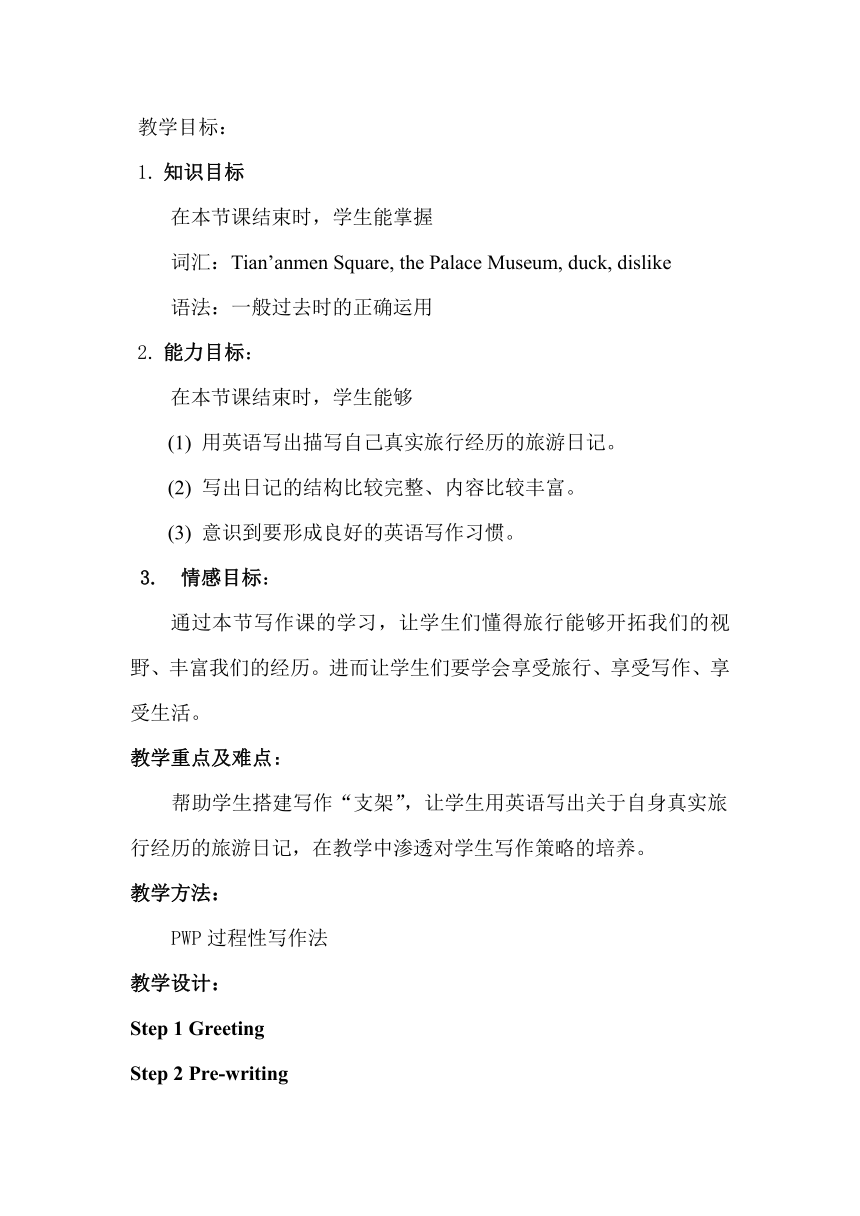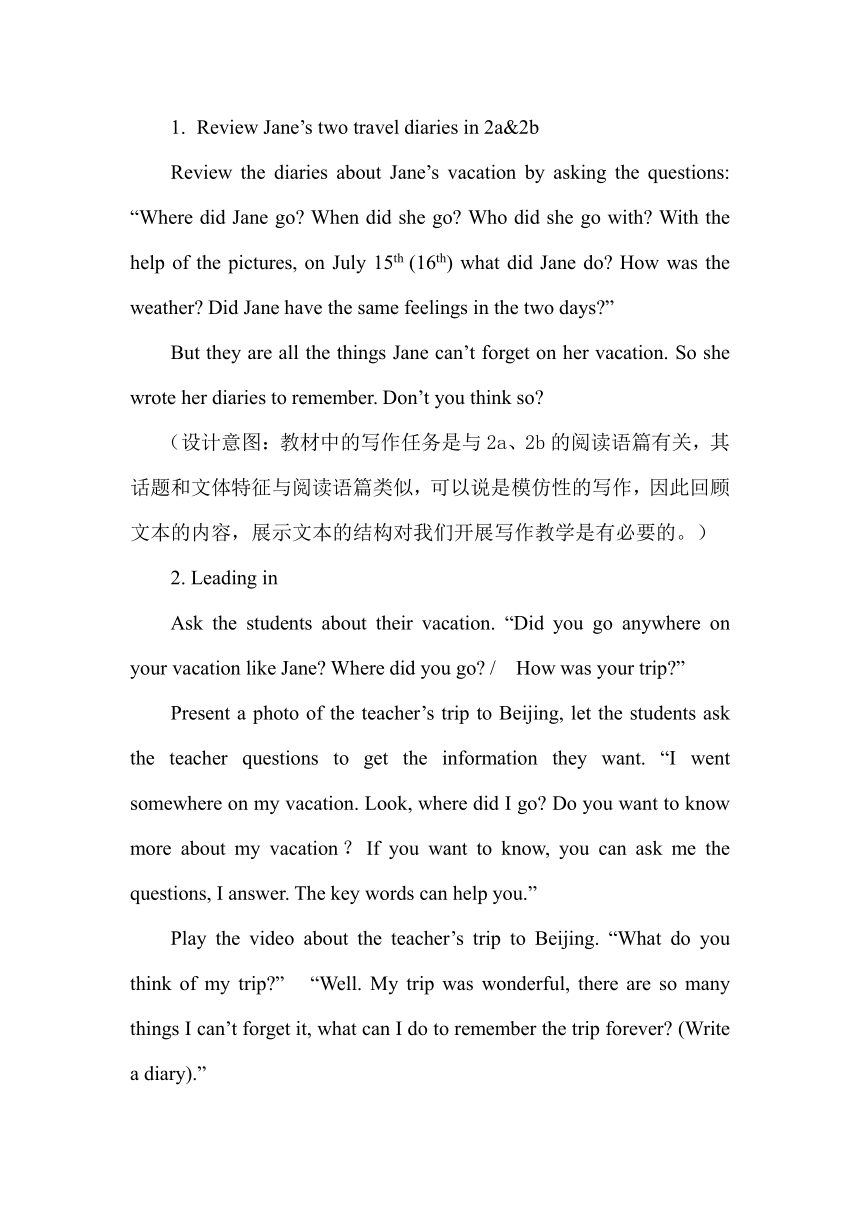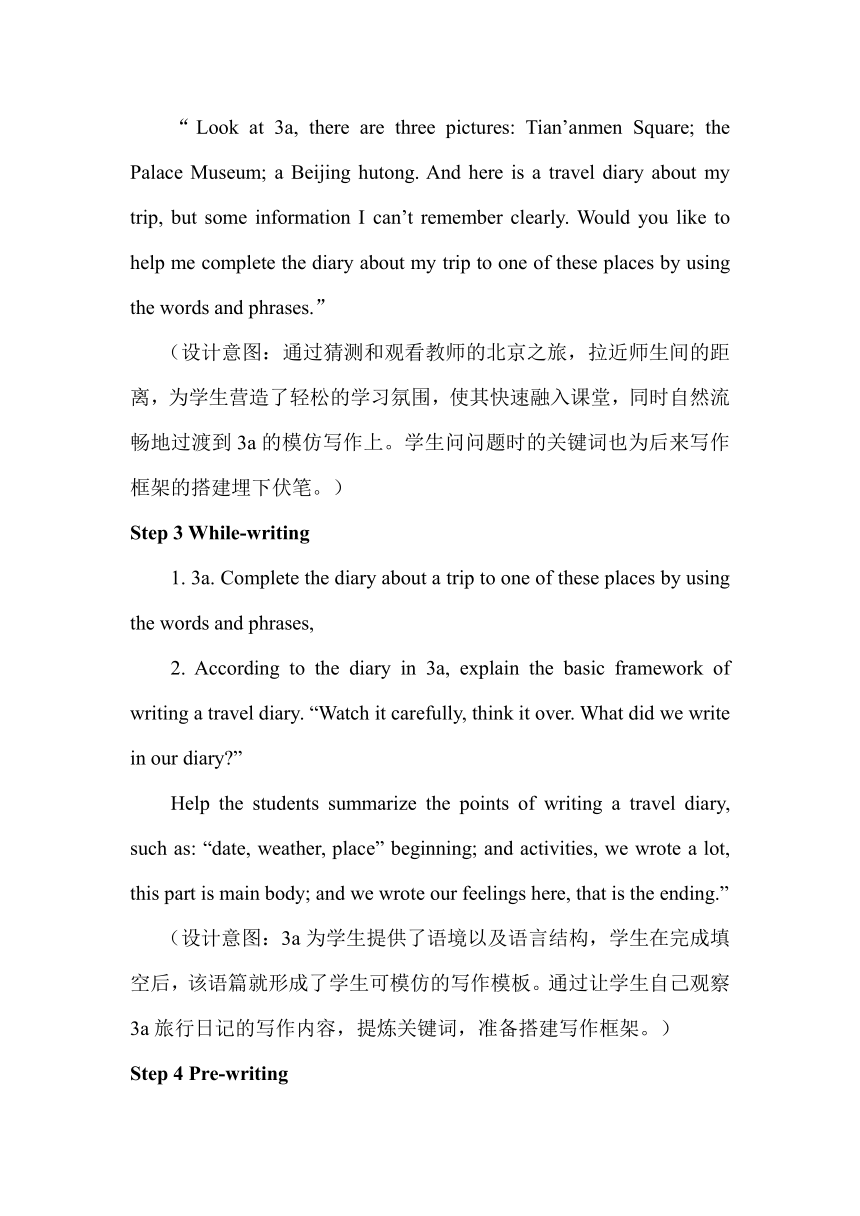人教新目标(Go for it)版八年级上册Unit 1 Where did you go on vacation? Section B 3a-3c教案
文档属性
| 名称 | 人教新目标(Go for it)版八年级上册Unit 1 Where did you go on vacation? Section B 3a-3c教案 |

|
|
| 格式 | zip | ||
| 文件大小 | 36.0KB | ||
| 资源类型 | 教案 | ||
| 版本资源 | 人教新目标(Go for it)版 | ||
| 科目 | 英语 | ||
| 更新时间 | 2023-01-20 18:01:26 | ||
图片预览




文档简介
Unit 1 Where did you go on vacation
Section B 3a-3c
教学内容分析:
八年级上册Unit 1围绕 “节日和假期(Holidays and vacations)”为话题而展开活动。Section B 3a-3c活动以北京为假想旅游地,引导学生展开写作活动。3a为学生提供了语境以及语言结构。学生在完成填空后,该语篇就形成了学生可模仿的写作模板。3b通过一系列有关假期的问题为学生提供了写作要点和思路,3c要求学生将写作落实到语篇,要求学生在写作中熟练运用过去式,并且能模仿阅读语篇写出日记这种应用文体裁。学生对所写内容越感兴趣和熟悉,就越有话可说,也更易于在写作练习中将思维的焦点放在运用语言表达自己的意思上。
学生情况分析:
写作是一种难度较高的语言输出活动。对于刚上八年级的学生来说还是困难较大的。但本课的写作内容“旅游”与他们的现实生活紧密相连,也是他们非常感兴趣的话题,他们有话可说,有事情可写。
本节课为了帮助学生较好的进行英语写作,教师采用写前、写中、写后的过程性写作模式。在本节课的教学中,教师让学生通过讨论写作的话题、分析范文结构、就话题展开调查等活动分解写作过程,以降低写作任务的难度,减少学生在写作过程中的焦虑感。这些活动不仅有助于学生用英语构思,形成合理的写作思路,顺利完成写作任务,还能让学生养成良好的写作习惯,增强学生用英语写作的自信心。
根据本课时在教材中的地位和作用,依据教学大纲,确定以下教学目标:
知识目标
在本节课结束时,学生能掌握
词汇:Tian’anmen Square, the Palace Museum, duck, dislike
语法:一般过去时的正确运用
能力目标:
在本节课结束时,学生能够
(1) 用英语写出描写自己真实旅行经历的旅游日记。
(2) 写出日记的结构比较完整、内容比较丰富。
(3) 意识到要形成良好的英语写作习惯。
3. 情感目标:
通过本节写作课的学习,让学生们懂得旅行能够开拓我们的视野、丰富我们的经历。进而让学生们要学会享受旅行、享受写作、享受生活。
教学重点及难点:
帮助学生搭建写作“支架”,让学生用英语写出关于自身真实旅行经历的旅游日记,在教学中渗透对学生写作策略的培养。
教学方法:
PWP过程性写作法
教学设计:
Step 1 Greeting
Step 2 Pre-writing
Review Jane’s two travel diaries in 2a&2b
Review the diaries about Jane’s vacation by asking the questions: “Where did Jane go When did she go Who did she go with With the help of the pictures, on July 15th (16th) what did Jane do How was the weather Did Jane have the same feelings in the two days ”
But they are all the things Jane can’t forget on her vacation. So she wrote her diaries to remember. Don’t you think so
(设计意图:教材中的写作任务是与2a、2b的阅读语篇有关,其话题和文体特征与阅读语篇类似,可以说是模仿性的写作,因此回顾文本的内容,展示文本的结构对我们开展写作教学是有必要的。)
2. Leading in
Ask the students about their vacation. “Did you go anywhere on your vacation like Jane Where did you go / How was your trip ”
Present a photo of the teacher’s trip to Beijing, let the students ask the teacher questions to get the information they want. “I went somewhere on my vacation. Look, where did I go Do you want to know more about my vacation?If you want to know, you can ask me the questions, I answer. The key words can help you.”
Play the video about the teacher’s trip to Beijing. “What do you think of my trip ” “Well. My trip was wonderful, there are so many things I can’t forget it, what can I do to remember the trip forever (Write a diary).”
“Look at 3a, there are three pictures: Tian’anmen Square; the Palace Museum; a Beijing hutong. And here is a travel diary about my trip, but some information I can’t remember clearly. Would you like to help me complete the diary about my trip to one of these places by using the words and phrases.”
(设计意图:通过猜测和观看教师的北京之旅,拉近师生间的距离,为学生营造了轻松的学习氛围,使其快速融入课堂,同时自然流畅地过渡到3a的模仿写作上。学生问问题时的关键词也为后来写作框架的搭建埋下伏笔。)
Step 3 While-writing
1. plete the diary about a trip to one of these places by using the words and phrases,
2. According to the diary in 3a, explain the basic framework of writing a travel diary. “Watch it carefully, think it over. What did we write in our diary ”
Help the students summarize the points of writing a travel diary, such as: “date, weather, place” beginning; and activities, we wrote a lot, this part is main body; and we wrote our feelings here, that is the ending.”
(设计意图:3a为学生提供了语境以及语言结构,学生在完成填空后,该语篇就形成了学生可模仿的写作模板。通过让学生自己观察3a旅行日记的写作内容,提炼关键词,准备搭建写作框架。)
Step 4 Pre-writing
1. Build the framework of writing a travel diary.
“3a is too simple, we need to write a better one. But how to write a better one (PPT呈现思维导图)Look at the points. Do you still remember the points What can be put in the beginning How about main body How about the ending ” (PPT动态图)
In the diary, we write the things we can’t forget. So look, it is the framework of a travel diary. (展示完整的框架图)
(设计意图:3a搭建的写作框架是个基本的框架,在此环节中可引导学生展开联想,丰富所写内容的线索,从而激活旅游的背景知识,让学生的思维更开放,鼓励学生创新思维。)
2. Present the model essay about the teacher’s trip to Beijing. And summarize the tips for writing a travel diary.
T: “According to the framework, I wrote another travel diary. It is longer with more information. Let’s read it together, OK ”
“Is that a better travel diary Why did you say so In what way do you think is good / What is good ”
Guide the students to think about how to write a good travel diary and help them to summarize the tips for writing.
TIP1:Frame and content
TIP2:Good language
TIP3: Correct grammar
TIP4: Good handwriting
(设计意图:此环节提供给学生一个更好的写作模板。引导学生通过观察,发现、评价这篇旅行日记的写作内容,进而总结出写英语日记及英语作文应注意的四大问题,让学生理清好自己用英语写作的思路。教师在写作前给予学生有针对性的指导,让学生更好地关注了篇章的结构和内容,了解英语写作中常见的问题,为学生的写作做足了准备。)
3. Pair work. List the information about the students’ trips in the chart by asking and answering the questions in 3b.
Beginning time place Partner(with whom) weather
Main body (activities)
Ending (feelings)
(设计意图:让学生在小组活动中通过问题的引导回顾自己真实的旅游经历。本环节的设计在于为学生提供了写作的要点和思路,学生只有在写之前搭建好框架,准备好写的素材才能游刃有余地去写作。)
Step 5 While-writing
With the help of the chart, it’s your turn to write your own travel diary. 8 minutes for you. Volunteers, write on the blackboard. (二名学生在黑板上写作)
Step 6 Post-writing
1. Check (Modify) one of the two students’ diaries together with the symbols. (PPT显示修改符号;评价标准以及总评的标准)
(设计意图:课堂上教师应对学生的作品作出及时的反馈,在此环节教师教会学生如何通过writing tips来评价作文(包括使用一定的符号),让学生学会点评。在批改时教师带着欣赏的眼光,努力发现“闪光点”,帮助学生建立自信。)
2. Exchange the diary with a partner. And modify and evaluate each other. Ask the students to pay attention to the tips. And ask someone to talk about how he/she modify the diary.
(设计意图:评价的主体不应局限于教师,还应体现学生的主体地位,让学生通过修改同伴的作文,肯定进步,反思问题。)
3. The teacher should have the investigation about the students’ diaries, and encourage them to do better next time.
4. The homework
The homework is to modify your travel diaries again. And then write it in exercise books.
(设计意图:好的作文是改出来的,“文章不厌百回改”。教师要有意识的引导学生了解修改作文的重要性。要引导学生通过自该、互改,取长补短,不断提高写作水平。)
Section B 3a-3c
教学内容分析:
八年级上册Unit 1围绕 “节日和假期(Holidays and vacations)”为话题而展开活动。Section B 3a-3c活动以北京为假想旅游地,引导学生展开写作活动。3a为学生提供了语境以及语言结构。学生在完成填空后,该语篇就形成了学生可模仿的写作模板。3b通过一系列有关假期的问题为学生提供了写作要点和思路,3c要求学生将写作落实到语篇,要求学生在写作中熟练运用过去式,并且能模仿阅读语篇写出日记这种应用文体裁。学生对所写内容越感兴趣和熟悉,就越有话可说,也更易于在写作练习中将思维的焦点放在运用语言表达自己的意思上。
学生情况分析:
写作是一种难度较高的语言输出活动。对于刚上八年级的学生来说还是困难较大的。但本课的写作内容“旅游”与他们的现实生活紧密相连,也是他们非常感兴趣的话题,他们有话可说,有事情可写。
本节课为了帮助学生较好的进行英语写作,教师采用写前、写中、写后的过程性写作模式。在本节课的教学中,教师让学生通过讨论写作的话题、分析范文结构、就话题展开调查等活动分解写作过程,以降低写作任务的难度,减少学生在写作过程中的焦虑感。这些活动不仅有助于学生用英语构思,形成合理的写作思路,顺利完成写作任务,还能让学生养成良好的写作习惯,增强学生用英语写作的自信心。
根据本课时在教材中的地位和作用,依据教学大纲,确定以下教学目标:
知识目标
在本节课结束时,学生能掌握
词汇:Tian’anmen Square, the Palace Museum, duck, dislike
语法:一般过去时的正确运用
能力目标:
在本节课结束时,学生能够
(1) 用英语写出描写自己真实旅行经历的旅游日记。
(2) 写出日记的结构比较完整、内容比较丰富。
(3) 意识到要形成良好的英语写作习惯。
3. 情感目标:
通过本节写作课的学习,让学生们懂得旅行能够开拓我们的视野、丰富我们的经历。进而让学生们要学会享受旅行、享受写作、享受生活。
教学重点及难点:
帮助学生搭建写作“支架”,让学生用英语写出关于自身真实旅行经历的旅游日记,在教学中渗透对学生写作策略的培养。
教学方法:
PWP过程性写作法
教学设计:
Step 1 Greeting
Step 2 Pre-writing
Review Jane’s two travel diaries in 2a&2b
Review the diaries about Jane’s vacation by asking the questions: “Where did Jane go When did she go Who did she go with With the help of the pictures, on July 15th (16th) what did Jane do How was the weather Did Jane have the same feelings in the two days ”
But they are all the things Jane can’t forget on her vacation. So she wrote her diaries to remember. Don’t you think so
(设计意图:教材中的写作任务是与2a、2b的阅读语篇有关,其话题和文体特征与阅读语篇类似,可以说是模仿性的写作,因此回顾文本的内容,展示文本的结构对我们开展写作教学是有必要的。)
2. Leading in
Ask the students about their vacation. “Did you go anywhere on your vacation like Jane Where did you go / How was your trip ”
Present a photo of the teacher’s trip to Beijing, let the students ask the teacher questions to get the information they want. “I went somewhere on my vacation. Look, where did I go Do you want to know more about my vacation?If you want to know, you can ask me the questions, I answer. The key words can help you.”
Play the video about the teacher’s trip to Beijing. “What do you think of my trip ” “Well. My trip was wonderful, there are so many things I can’t forget it, what can I do to remember the trip forever (Write a diary).”
“Look at 3a, there are three pictures: Tian’anmen Square; the Palace Museum; a Beijing hutong. And here is a travel diary about my trip, but some information I can’t remember clearly. Would you like to help me complete the diary about my trip to one of these places by using the words and phrases.”
(设计意图:通过猜测和观看教师的北京之旅,拉近师生间的距离,为学生营造了轻松的学习氛围,使其快速融入课堂,同时自然流畅地过渡到3a的模仿写作上。学生问问题时的关键词也为后来写作框架的搭建埋下伏笔。)
Step 3 While-writing
1. plete the diary about a trip to one of these places by using the words and phrases,
2. According to the diary in 3a, explain the basic framework of writing a travel diary. “Watch it carefully, think it over. What did we write in our diary ”
Help the students summarize the points of writing a travel diary, such as: “date, weather, place” beginning; and activities, we wrote a lot, this part is main body; and we wrote our feelings here, that is the ending.”
(设计意图:3a为学生提供了语境以及语言结构,学生在完成填空后,该语篇就形成了学生可模仿的写作模板。通过让学生自己观察3a旅行日记的写作内容,提炼关键词,准备搭建写作框架。)
Step 4 Pre-writing
1. Build the framework of writing a travel diary.
“3a is too simple, we need to write a better one. But how to write a better one (PPT呈现思维导图)Look at the points. Do you still remember the points What can be put in the beginning How about main body How about the ending ” (PPT动态图)
In the diary, we write the things we can’t forget. So look, it is the framework of a travel diary. (展示完整的框架图)
(设计意图:3a搭建的写作框架是个基本的框架,在此环节中可引导学生展开联想,丰富所写内容的线索,从而激活旅游的背景知识,让学生的思维更开放,鼓励学生创新思维。)
2. Present the model essay about the teacher’s trip to Beijing. And summarize the tips for writing a travel diary.
T: “According to the framework, I wrote another travel diary. It is longer with more information. Let’s read it together, OK ”
“Is that a better travel diary Why did you say so In what way do you think is good / What is good ”
Guide the students to think about how to write a good travel diary and help them to summarize the tips for writing.
TIP1:Frame and content
TIP2:Good language
TIP3: Correct grammar
TIP4: Good handwriting
(设计意图:此环节提供给学生一个更好的写作模板。引导学生通过观察,发现、评价这篇旅行日记的写作内容,进而总结出写英语日记及英语作文应注意的四大问题,让学生理清好自己用英语写作的思路。教师在写作前给予学生有针对性的指导,让学生更好地关注了篇章的结构和内容,了解英语写作中常见的问题,为学生的写作做足了准备。)
3. Pair work. List the information about the students’ trips in the chart by asking and answering the questions in 3b.
Beginning time place Partner(with whom) weather
Main body (activities)
Ending (feelings)
(设计意图:让学生在小组活动中通过问题的引导回顾自己真实的旅游经历。本环节的设计在于为学生提供了写作的要点和思路,学生只有在写之前搭建好框架,准备好写的素材才能游刃有余地去写作。)
Step 5 While-writing
With the help of the chart, it’s your turn to write your own travel diary. 8 minutes for you. Volunteers, write on the blackboard. (二名学生在黑板上写作)
Step 6 Post-writing
1. Check (Modify) one of the two students’ diaries together with the symbols. (PPT显示修改符号;评价标准以及总评的标准)
(设计意图:课堂上教师应对学生的作品作出及时的反馈,在此环节教师教会学生如何通过writing tips来评价作文(包括使用一定的符号),让学生学会点评。在批改时教师带着欣赏的眼光,努力发现“闪光点”,帮助学生建立自信。)
2. Exchange the diary with a partner. And modify and evaluate each other. Ask the students to pay attention to the tips. And ask someone to talk about how he/she modify the diary.
(设计意图:评价的主体不应局限于教师,还应体现学生的主体地位,让学生通过修改同伴的作文,肯定进步,反思问题。)
3. The teacher should have the investigation about the students’ diaries, and encourage them to do better next time.
4. The homework
The homework is to modify your travel diaries again. And then write it in exercise books.
(设计意图:好的作文是改出来的,“文章不厌百回改”。教师要有意识的引导学生了解修改作文的重要性。要引导学生通过自该、互改,取长补短,不断提高写作水平。)
同课章节目录
- Unit 1 Where did you go on vacation?
- Section A
- Section B
- Unit 2 How often do you exercise?
- Section A
- Section B
- Unit 3 I'm more outgoing than my sister.
- Section A
- Section B
- Unit 4 What's the best movie theater?
- Section A
- Section B
- Unit 5 Do you want to watch a game show?
- Section A
- Section B
- Unit 6 I'm going to study computer science.
- Section A
- Section B
- Unit 7 Will people have robots?
- Section A
- Section B
- Unit 8 How do you make a banana milk shake?
- Section A
- Section B
- Unit 9 Can you come to my party?
- Section A
- Section B
- Unit 10 If you go to the party, you'll have a grea
- Section A
- Section B
